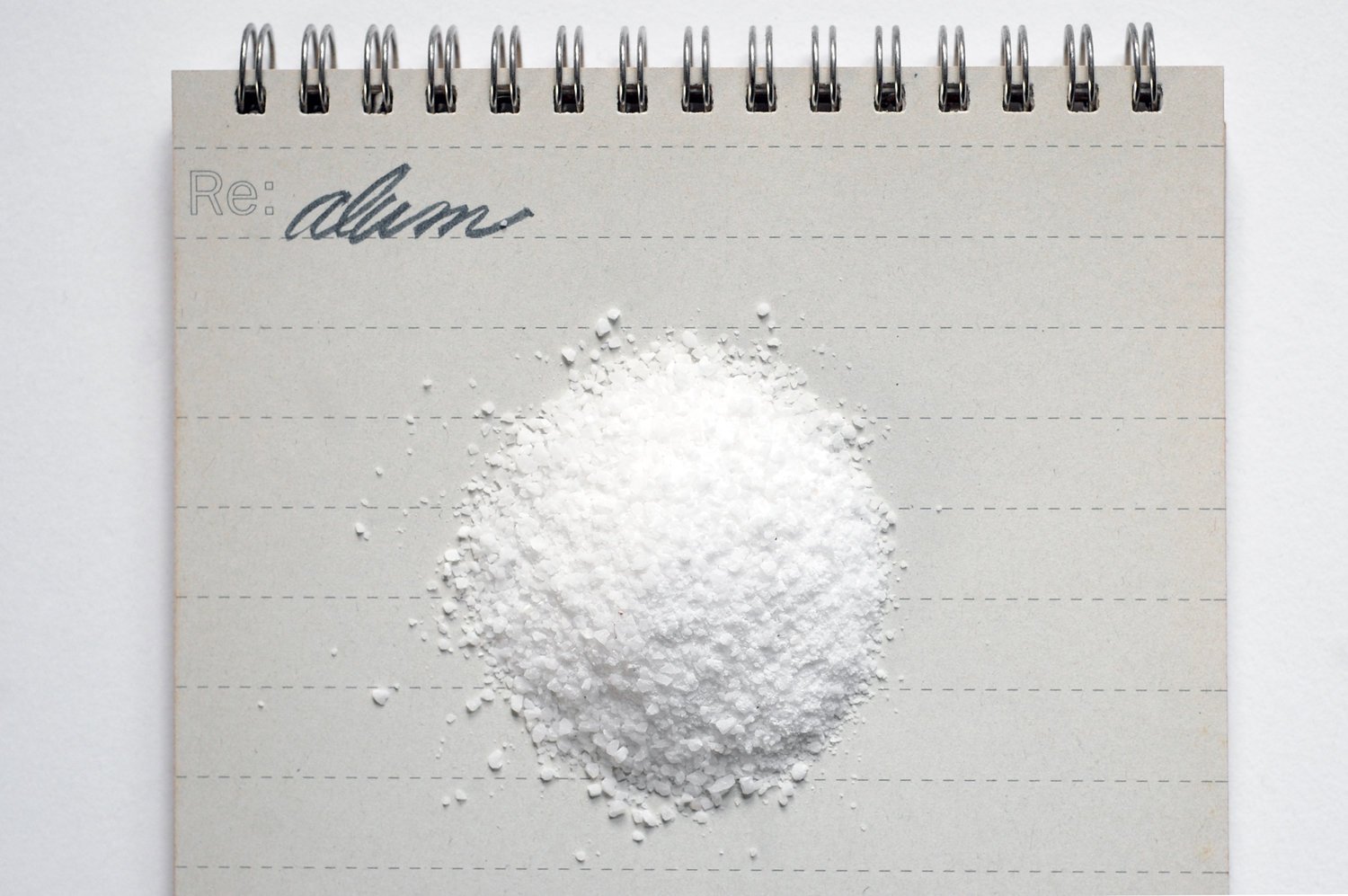alum quantity for fabric marbling
Natalie Stopka, January 2019
Recently I’ve looked into the types of alum and the quantity necessary for marbling paper; now let’s turn to fabric marbling. There are a lot of different recipes for mordanting fabric prior to marbling, but with my natural dyeing experience to guide me, I’d like to share my method.
Remember that alum is the compound most commonly used to mordant both fabric and paper. It bonds readily and permanently to other molecules, creating a link between fiber and marbling pigment. Our aim in mordanting is to evenly apply an alum solution to our fabric before marbling, just enough for a permanent print.
Fiber preparation
Firstly, choose an absorbent natural fiber or blend for your fabric. Thoroughly wash the fabric to remove any starch, sizing, or dirt from its surface - these will impede both the mordant and marbling from being absorbed.
Mordanting by weight
Using a metric baker’s scale, weigh your dry fabric (this can be done before washing).
For plant fibers (cotton, linen, bamboo, ramie, hemp) or fiber blends, measure alum equal to 15% of the weight of your dry fabric.
For animal fibers (silk), measure alum equal to 8% of the weight of your dry fabric.
Fill a clean container with enough warm water for your fabric to swim freely. This can be a bucket, plastic storage container, or your bathtub. Add the alum to the water, stirring until it is completely dissolved. Lower your fabric into the alum solution, swishing it around to release air bubbles. Leave the fabric to soak for 40-60 minutes, stirring every 15 minutes for even absorption.
Empty your mordanting container and fill with fresh water. Rinse your fabric 1-2 times by wafting it through the water to remove excess alum.
Hang the fabric to dry. Mordanted fabric may be stored for up to 6 months before use. Iron with steam before marbling.
Mordanting by volume
If you don’t have a baker’s scale, you may choose to mordant by volume instead of weight. It’s not quite as scientific for large amounts of fabric, but it works well for small projects.
Find a container large enough for your fabric to be fully submerged and swim freely when it is unfurled. Fill this with warm water, measuring as you go. For every quart of water, add 1 1/2 teaspoons of alum (that’s 2 tablespoons/gallon). Stir until the alum is completely dissolved, then lower your fabric into the alum solution. Swish it around to release air bubbles and leave the fabric to soak for 20 minutes.
Empty your mordanting container and fill with fresh water. Rinse your fabric 1-2 times by wafting it through the water to remove excess alum that is not bonded to the fabric.
Hang the fabric to dry. Mordanted fabric may be stored for up to 6 months before use. Iron with steam before marbling.
The dangers of poor mordanting
I’ve seen recipes calling for as much as 1 1/4 cups alum (20 tablespoons) per gallon of water. That’s a lot. The problem with mixing a very strong mordant solution by following a heavy-handed recipe or failing to follow any recipe whatsoever may not be immediately evident. But some problems might arise:
Alum is slightly acidic. You can over-mordant your fabric by mixing a very strong alum solution or leaving the fabric to soak too long. Over time, that acidity causes the fibers to become brittle and break apart. If your marbled fabrics feel very dry or brittle, or if they tear during washing or sewing, they are likely over-mordanted.
I’ve read that alum ‘eats’ or ‘decomposes’ fabric, and it should never be mordanted more than a few days prior to marbling. This is true only if you over-mordant and thus leave your fabric in an acidic state. Following a decent recipe will allow you to mordant fabric months in advance of marbling with no detriment.
Failing to rinse your fabric after mordanting can leave it with excess alum sitting on the surface that is not bonded to the fibers. If the un-rinsed fabric dries with any wrinkles, that alum can pool in the creases and give you a streaky print.
Fabrics that have not been rinsed can deposit excess alum into the size, degrading it over the course of multiple prints. Or worse, your print may bond to the layer of alum sitting on the surface of the fabric, then flake off during rinsing.
Unfortunately fabric that is badly over-mordanted cannot be saved; alum forms permanent bonds and cannot be removed. If you have a batch of fabric exhibiting any of the issues above, best scrap it and start fresh. Small amounts of mordanted natural fiber fabrics (not yet printed) can be torn into thin strips and added to the compost.
